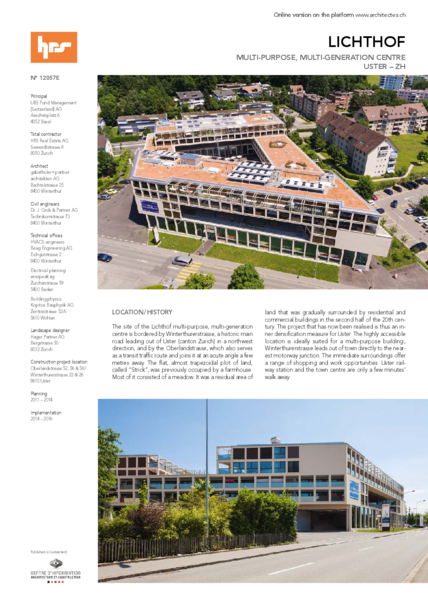Lichthof - E
Bâtiments administratif et commerces
Bâtiments administratif et commerces
LOCATION/HISTORY
The site of the Lichthof multi-purpose, multi-generation centre is bordered by Winterthurerstrasse, a historic main road leading out of Uster (canton Zurich) in a northwest direction, and by the Oberlandstrasse, which also serves as a transit traffic route and joins it at an acute angle a few metres away. The flat, almost trapezoidal plot of land, called “Strick”, was previously occupied by a farmhouse. Most of it consisted of a meadow. It was a residual area of land that was gradually surrounded by residential and commercial buildings in the second half of the 20th century. The project that has now been realised is thus an inner densification measure for Uster. The highly accessible location is ideally suited for a multi-purpose building ; Winterthurerstrasse leads out of town directly to the nearest motorway junction. The immediate surroundings offer a range of shopping and work opportunities. Uster railway station and the town centre are only a few minutes’ walk away.
Construction of the structure was preceded by a development phase by bryner entwicklungs ag that lasted several years. The project design originates from gabathuler + partner architekten ag (gabathuler + partner took over the bryner architekten ag business in 2015).
CONCEPT/ARCHITECTURE
In terms of layout, the new structure follows the boundaries of the site to create a rectangular block accessible from all sides with an open, partially landscaped inner courtyard with three different levels. The buildings along Winterthur and Oberlandstrasse are five-storeys high. There are large terraces between the base area and the two top floors. The three-storey transverse blocks have high, wide openings at street level. They make the courtyard accessible to pedestrians and motor vehicles and integrate it into the public road network. The corner and side areas of the block are characterised by projections and recesses. They reinforce the image of an architecture made up of stacked, massive and solid looking, cubically closed structures and integrate the large, modularly constructed complex with its regularly gridded facades into the mostly small-format
environment.
A parking garage with 197 parking spaces occupies most of the two basement floors. It is accessed via a ramp in the northern transverse block. The first basement also houses a retail outlet. It is connected to the street level by travelators and is accessible for pedestrians from the south side. The shop, which is below ground level, receives daylight through the facade. Slightly elevated office and business premises are located above it. On the ground floor, there is a bakery on Oberlandstrasse with a restaurant and shopping area with a separate access for vehicles and outside parking spaces.
On the courtyard side, the restaurant can set up a promenade café below the terrace opening and the slightly projecting floors above. The 1st and 2nd floors are limited to the transverse blocks between the terrace areas. The Neuwies old-age and care centre is located in the southern transverse block. Its dining room is located on the terrace area overlooking the Oberlandstrasse. The 46 single and three twin-bed rooms of the centre, arranged along a central corridor, all have generously dimensioned loggias. The terrace area above Winterthurerstrasse merges directly into the publicly accessible courtyard. A generous cascade of stairs leads down to the town’s network of paths via an intermediate level. Both terrace areas araccessible from the stairwells of the northern block, which accommodates some of the 54 apartments. Almost all of these have a loggia or terrace and are oriented towards both the courtyard and the access area along the east facade.
The two top floors are limited to the blocks along the streets. They also contain apartments. These units are accessible via central corridors. Residents of the 1-bedroom to 3-bedroom apartments in the medium-price segment can conclude a care contract with the Neuwies old-age and care centre if required. The care contract is particularly attractive for people who enjoy participating in social life at the Lichthof and in Uster even in old age. Among other things, it offers a 24-hour emergency call service, participation in the operations of the centre or cleaning and housekeeping services.
ENERGY EFFICIENCY
The multi-purpose, multi-generation Lichthof centre meets the Minergie standard. Waste heat from the sales and retail areas is used as an energy source for two heat pumps that raise its temperature to a level that can be used for heating purposes. If the waste heat produced is insufficient, the air is also used as an energy source via the external units. A cubic storage tank with a capacity of 18,000 litres is available. High-efficiency, thermal solar collectors are installed to heat the water. For reasons of operational safety and to support operation during periods of low outside temperatures, a heat generator with a condensing gas boiler is used in addition.
 Accès membres
Accès membres

 Page précédente
Page précédente



